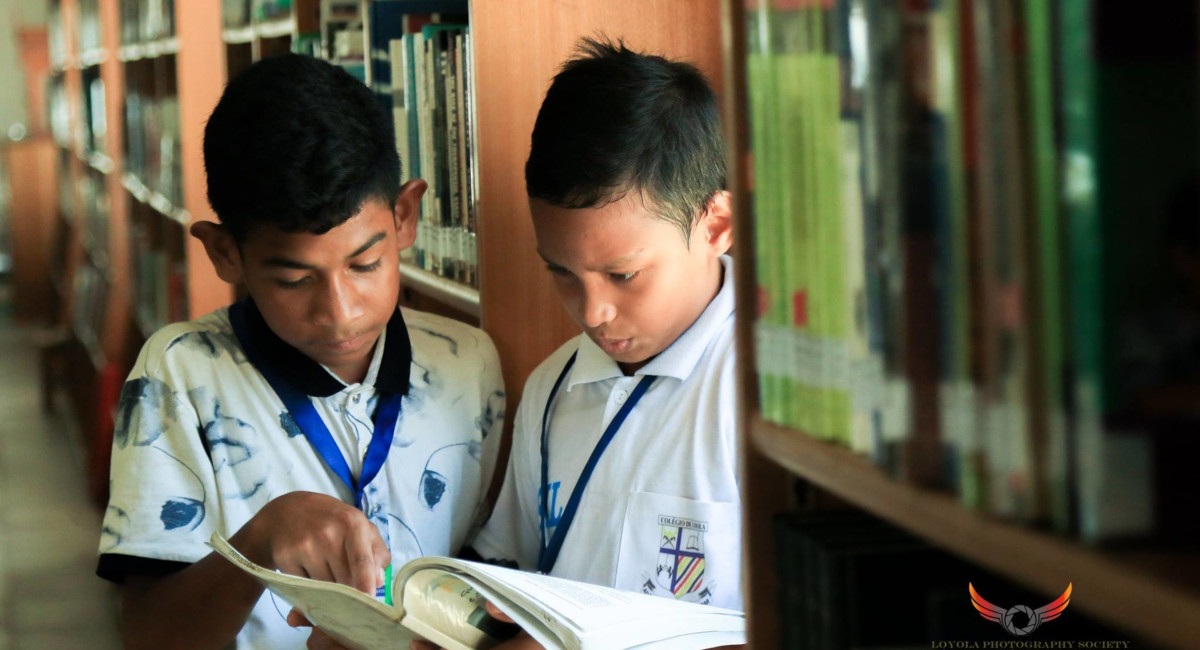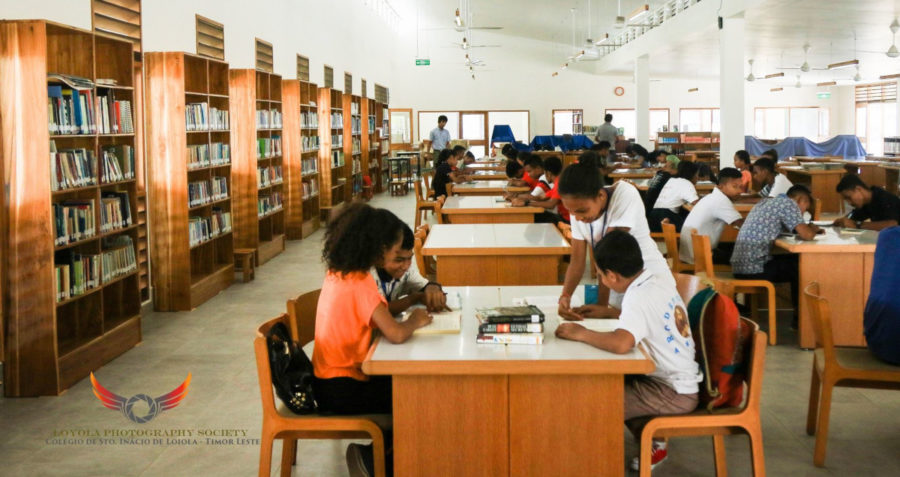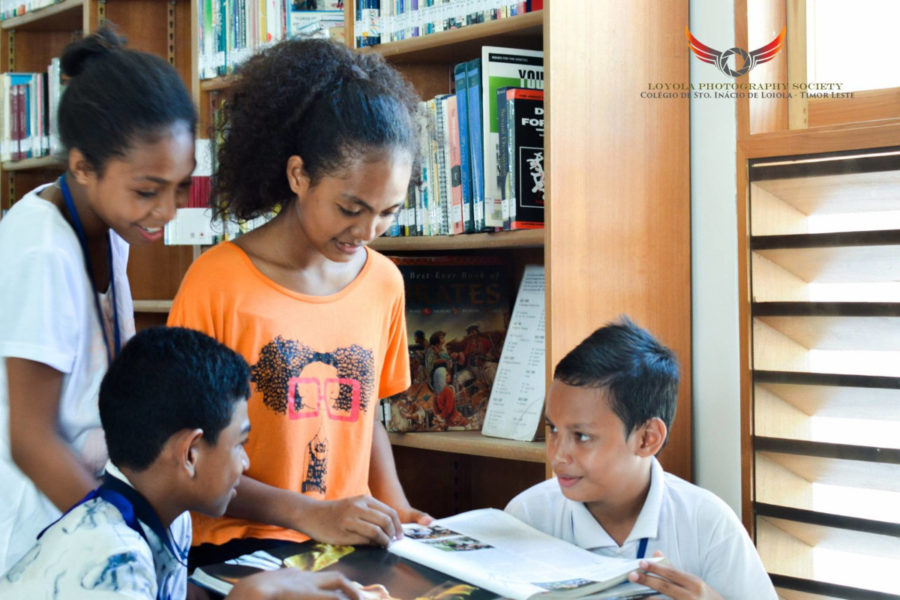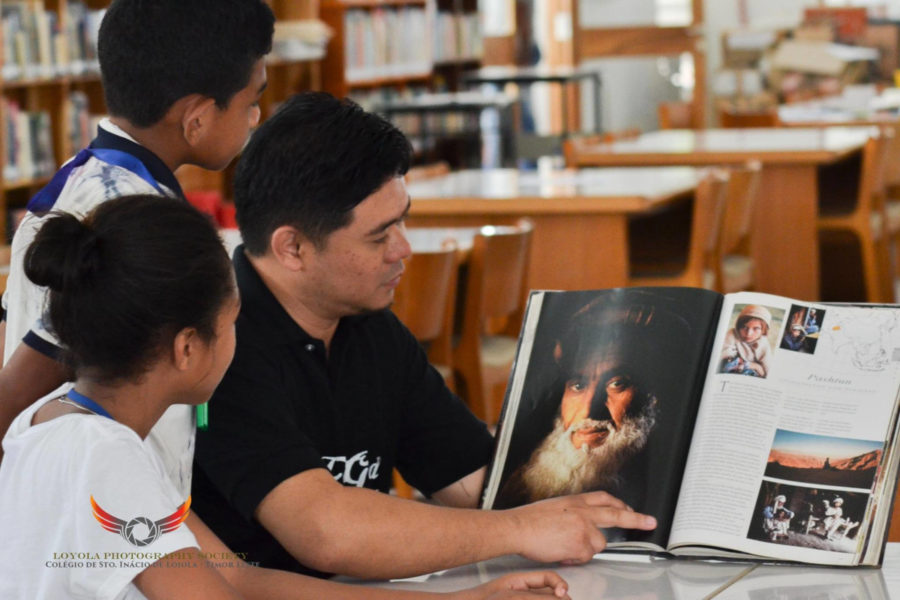 A good school produces good students who learn and thrive in the right environment, not only in the classroom but outside of it. The school library, well stocked and accessible, is one of the most important places for this.
A good school produces good students who learn and thrive in the right environment, not only in the classroom but outside of it. The school library, well stocked and accessible, is one of the most important places for this.
Here, a story about the Biblioteca Aparicio, the library of Colegio de Santo Loiola in Timor-Leste, where the students are learning how to properly use it as they develop a love for reading.
Enabling a culture of reading
 “We have a very good library; perhaps, the best in East Timor”, wrote Fr Bert Boholst SJ in the year-end Director’s Report in 2018. This is a great advantage for the students of Colégio de Santo Inácio de Loiolá (CSIL) in Timor-Leste. A Jesuit Education Project, this fairly young secondary school is flourishing as it focuses on the “4 Cs” of Jesuit education: competence, conscience, compassion and commitment. In 2013, they opened with a first intake of Year 7 students and by December 2018 they had graduated, with a 100 percent passing rate and Loiolá students getting the top three places in the National Examinations for Senior High.
“We have a very good library; perhaps, the best in East Timor”, wrote Fr Bert Boholst SJ in the year-end Director’s Report in 2018. This is a great advantage for the students of Colégio de Santo Inácio de Loiolá (CSIL) in Timor-Leste. A Jesuit Education Project, this fairly young secondary school is flourishing as it focuses on the “4 Cs” of Jesuit education: competence, conscience, compassion and commitment. In 2013, they opened with a first intake of Year 7 students and by December 2018 they had graduated, with a 100 percent passing rate and Loiolá students getting the top three places in the National Examinations for Senior High.
The library at CSIL is named after Fr Sebastião Maria Aparício da Silva SJ, the Jesuit missionary from Portugal. (He was one of the first Jesuits to work in East Timor from 1877-1910 and wrote the first Tetum Dictionary.) True to the international spirit of the Society of Jesus, putting the library together in 2017 was a collaborative effort from across the world. “Somebody from Australia helped in the construction of our library”, recalls Fr Boholst. “Our Jesuit school in Japan sent tables and chairs, made back then by the German Jesuits.” Contributions from donors were used for construction of shelves and furniture.
 Today, the Biblioteca Aparício is run by Fr Peter Yoshitaka Ura SJ of the Japanese Province. “Fr Ura single-handedly opened, ran and managed the library”, says Fr Boholst. “At the moment, we are trying out some local teachers to work as the librarian.” This comes with its own set of challenges: there are four teachers on trial basis, but they do not have a solid background in library work. The library is closed when Fr Ura is not around. But the “Japanese meticulous ways and discipline” are paying off. Fr Ura had help with establishing a system for coding and other related library works, while the borrowing system is already electronic. According to Fr Boholst, “Fr Ura is a very good librarian and a very hard-working Jesuit, so we have a very good library, something like we have in Japanese Jesuit schools.”
Today, the Biblioteca Aparício is run by Fr Peter Yoshitaka Ura SJ of the Japanese Province. “Fr Ura single-handedly opened, ran and managed the library”, says Fr Boholst. “At the moment, we are trying out some local teachers to work as the librarian.” This comes with its own set of challenges: there are four teachers on trial basis, but they do not have a solid background in library work. The library is closed when Fr Ura is not around. But the “Japanese meticulous ways and discipline” are paying off. Fr Ura had help with establishing a system for coding and other related library works, while the borrowing system is already electronic. According to Fr Boholst, “Fr Ura is a very good librarian and a very hard-working Jesuit, so we have a very good library, something like we have in Japanese Jesuit schools.”
The Loiolá students are encouraged to read in Portuguese and English, indeed many of the books in the library are in English. “The students love to borrow the English books because they prefer to master English in preparation for their scholarship applications”, Fr Boholst says. (Fresh from graduation last December, CSIL’s top honour students are attending universities in Japan and South Korea.) The real challenge is finding good books in Portuguese. “It is very difficult to find and buy Portuguese books. And the Portuguese of our students and teachers is still not so good”, says Fr Boholst.
 Fr Boholst acknowledges the value of having a well-stocked library because it supplements the textbooks in use. “The library is very important, especially because our textbooks are very limited, very thin and haphazardly done”, he says. “Our textbooks are from the government’s Ministry of Education. Since we opened only in 2013, we did not receive the complete set of books that we need”, he adds.
Fr Boholst acknowledges the value of having a well-stocked library because it supplements the textbooks in use. “The library is very important, especially because our textbooks are very limited, very thin and haphazardly done”, he says. “Our textbooks are from the government’s Ministry of Education. Since we opened only in 2013, we did not receive the complete set of books that we need”, he adds.
Just like in other small mission schools in areas with no easy access to bookstores, a little resourcefulness goes a long way. “Fr Ura looked for sponsors and benefactors from Japan to help him print the necessary books”, says Fr Boholst. “All our Junior High School students have their textbooks. For Senior High, we are still trying to complete the set. Luckily, we were able to get the soft copies of the books.” Fr Ura saved the text books in the computers found in the library where students can make their own copy and/or read them. Other titles come from Australia, Singapore and Portugal. Fr Ura buys books from the local bookstore, but they actually have very few acquisitions.
 “I am very happy because a good number of our students are using the library”, Fr Boholst shares. He notes that many of them do not have the habit of reading, especially with social media competing for the attention of young people these days. But, Fr Boholst says, “Fr Ura trains them on proper etiquette and of course he instills in them real Japanese discipline. It is a big challenge to push them to use the library because they are not used to it.”
“I am very happy because a good number of our students are using the library”, Fr Boholst shares. He notes that many of them do not have the habit of reading, especially with social media competing for the attention of young people these days. But, Fr Boholst says, “Fr Ura trains them on proper etiquette and of course he instills in them real Japanese discipline. It is a big challenge to push them to use the library because they are not used to it.”
Some of the teachers at CSIL use the library for their classes. Br Jeff Pioquinto SJ of the Philippine Province taught literature at CSIL for two years and learned how to use creativity in his teaching approach. “I remember seeing poker and confused faces the moment I introduced literature to my students”, he remembers. Getting them to read was a challenge, just as it was to get them to use the library. “To deepen their experiences in wrestling with the texts, I would allow my students to go deeper by bringing all their experiences to the level of reflection… I noticed that my students learned how to read more when they were engaged, curious and reflective.” A library can be a place where this can happen–for students not just to learn, but expand, explore and inspire.
Photos courtesy of Br Jeff Pioquinto SJ and Loyola Photography Society, CSIL

